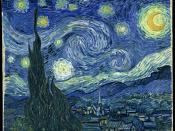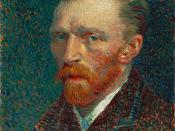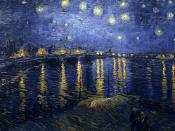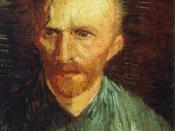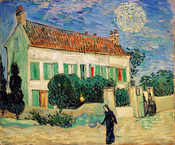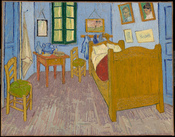What fascinates me much, much more than anything else in my métier is the portrait, the modern portrait . . . I should like to do portraits which will appear as revelations to people in 100 years time." - VINCENT VAN GOGH, 1890 What could be a more disturbing image than the one of Vincent Van Gogh as the wanderer? Of his time spent in poverty and isolation he sought to help those around him, and perhaps to find himself in the process. Picture Vincent as he gives his first Sunday sermon in Isleworth, outside of London. He was so passionate about his beliefs, but never really connected with the religious world. His sermon must have really been something.
Van gogh traveled to Brussels on foot to seek counsel from Pastor Pietersen at the evangelical college. He had no more than the a few sketches and the clothes on his back, but he needed guidance in his overwhelming desire to help others.
Van gogh's wanderings were not always religiously motivated. Another great image was when Vincent walked 70 kilometers to Courrières, France to see Jules Breton, a painter he admires. When he reached Breton's house, Vincent was too timid to knock.
Although Van gogh is known for his insanity and his close relationship with his brother, his relationship with other people is fascinating as well. His relationships with women are very captivating. The three main women in Van gogh's life were the prostitute, Sein, and his cousin, Kee.
Van gosh and Sien are both portrayed as lonely and desperate people. For some time, however, Van gogh and Sien brought some happiness into each other's lives. At the same time, Sien has always seemed fairly cold. Is it true? Maybe not--there's little bona fide information available about Sien, about her life and her feelings. What happened to her after she parted from Van gogh? It is said that she remarried but eventually committed suicide by drowning. She played an important role in Van Gogh's life.
There are many single events, which stand out in Van gogh's life (the ear-cutting is, of course, the one that most people are familiar with). Another specific moment find is when Van gogh confronts the parents of his cousin, Cornelia Adriana Vos-Stricker (Kee). Van gogh's love for Kee is unrequited, but he won't be turned away. Van gogh argues unsuccessfully with Kee's parents and then, in order to prove his determination, holds his hand over the funnel of an oil lamp, intentionally burning himself. Kee's father quickly defuses the situation by simply blowing out the lamp, but nevertheless it's an incredibly powerful image.
Here is another crucial point in Van Gogh's life. He was a passionate, often eccentric artist. The idea of Van gogh arguing art theory with other painters in Montmartre is a very strong image, but one of the most powerful and moving images come from his time in Arles. Here is Van gosh: deeply hopeful that his dream of establishing an artists' community in the south would soon come true. One of Van gogh's most personal works of his Arles period is Painter on His Way to Work. It's a very touching image--Vincent as the lone painter, trekking along the sun-scorched roads of Provence--looking for the right spot among the cypresses to set up his easel. There's as much of the real Van gogh in this small sketch as there is in any of his more famous self-portraits.
It's impossible not to be moved by the incredibly turbulent final years of Van gogh's life. Picture it--someone with a profound appreciation of nature and beauty one moment, and a seeming madman the next. The last images of Van gogh's life never fail to move anyone. Van gosh is dying from his self-inflicted gunshot wound and spends his last few hours on earth with the most important person in his life, his brother Theo. Theo had always been there for him--without Theo, there wouldn't have been the Van gogh we know today (to say nothing of his works). There they are, the two of them--Theo climbs into bed with Vincent, cradles his head and Van gogh says: "I wish I could pass away like this". It's an incredibly powerful image (mind you, other accounts tell us that Van gogh's last words were either "I wish it were all over now" or "The sadness will never end"--the image is the same). The burial is equally moving. There is Van gogh's coffin, covered with sunflowers and surrounded by a group of people who knew him and cared for him.
Here is a chronology of Vincent Van Gogh's life from the day he was born to the day he died.
1853- Van gosh is born on March 30 in the village of Groot-Zundert, Holland. His parents were Theodorus Van Gogh and Anna Cornelia nee Carbentus.
1857- Theo, Van gosh brother, is born 1869- After finishing school, Van Gogh is apprenticed to Goupil & Cie, art dealers from Paris.
1873- Van gosh is transferred to the London branch of Goupil & Cie where he visits the museums and galleries to further his knowledge of art.
1875- Van gogh's devotion to his bible studies starts to reach an obsessive level.
1876- Van gosh takes a new job as a teacher and curate with Reverend T. Slade Jones, a Methodist minister. On October 29 he delivers his first Sunday sermon.
1878- Van gogh's formal religious studies come to an end, but determined to pursue a religious vocation, he travels to the Borinage, a coal-mining district in Belgium.
1880- Van Gogh abandons his religious pursuits and devotes himself to painting the miners and poverty-stricken weavers.
1881- Van gosh visits Theo in Etten, later in the year, has his advances rejected by his cousin Cornelia Adriana Vos-Stricker (known as Kee). He spends time with the painter, Anton Mauve who introduces him to watercolors. The situation with Kee causes his mental state to deteriorate and his relationship with his father also begins to crumble.
1882-Van gosh meets Sein and they move in together.
1883- Van gosh ends his yearlong relationship with Sein and pursues a life dedicated exclusively to his work.
1885- Van gogh's father dies in March. Paints what some claim to be his first great work, The Potato Eaters.
1886- Van gosh withdraws from Ecole des Beaux-Arts because he rejected many of the principles he was taught. He moves to Paris and moves in with his brother Theo. Van gosh starts beginner classes at the Anthwerp Academy. He doesn't fit in, so he leaves.
1888- Van Gogh leaves Paris in February and moves to Arles. He paints some of his best work in this year. After a failed attack on his friend, Vincent cuts off his left ear lobe, wraps it in newspaper, and presents it to a prostitute at the local brothel. Shortly after that he was hospitalized and Theo comes to Paris to make plans for his brother's care.
1889- Van gosh leaves the hospital on January 7. After suffering frequent mental breakdowns, his brother helps him to enter Saint Paul-de-Mausole mental asylum. His paintings Starry Night over the Rhone and Irises are exhibited at the Salon des Independants in September and in November.
1890- Theo's wife gives birth to a baby boy on January 31. They name him Vincent Willhem. Van gosh has a serious attack in February that lasts for two months. He was put under the care of Dr. Paul Gachet. Van gosh began to paint with amazing energy and produced over 80 paintings in his last two months. On July 27, Van gosh takes a walk, and shoots himself in the chest. He died early in the morning on July 29. The funeral was held shortly after that with dozens of sunflowers covering the coffin.
In the painting Starry Night the main subject matter in this particular work is the sky and the stars swirling around. There is also a focus on the houses and the big tree that was put in the front of the painting. The texture of this painting is an oil paint on canvas.
The title Starry Night interprets the painting very well. The painting shows how there are a lot of stars in the sky and how they seem to be swirling around and around. There are many horizontal lines in this painting, which makes it seem really calm. There are also some diagonal lines that give the painting energy. This particular painting is balanced in an asymmetrical manner. The painting seems to be balanced, but it is not the same on both sides. It has different shapes and different colors on both sides. In the end, however, it all comes out looking as if it is evenly balanced. Hulsker, Jan. Vincent and Theo Van Gogh: A Dual Biography; Fuller Technical Publications; 1990.
Tralbaut, Marc Edo; Vincent Van Gogh. Viking, 1969.
Sweetman, David; The Love of Many Things: The Life of Vincent Van Gogh; Touchtone, 1990.
www.vangogh.com The ACCESS INDIANA Teaching and Learning Center, Vincent Van Gogh. Web page
